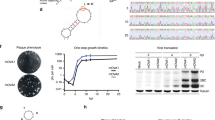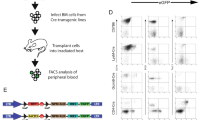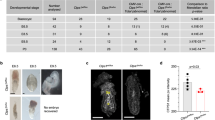Abstract
JCV is a papovavirus which is widespread in the human population. The prototype Mad-1 variant of JCV induces a fatal demyelinating disease of the central nervous system (CNS) called Progressive Multifocal Leukoencephalopathy (PML) in immunosuppressed individuals. The unique tropism of JCV (Mad-1) to the CNS is attributed to the tissue-specific regulation of the viral early promoter which is responsible for the production of the viral regulatory protein, T-antigen. The archetype form of this virus, JCV(CY), which has been repeatedly isolated from the urine of PML and non-PML individuals, is distinct from JCV(Mad-1) in the structural organization of the regulatory sequence. To characterize the tissue specific expression of JCV(CY) and to investigate its potential in inducing disease, transgenic mice containing the early region of JCV(CY) were generated. Some of these mice between 9 – 13 months of age exhibited signs of illness as manifested by paralysis of rear limbs, hunched posture, and poor grooming. Neuropathological examination indicated no sign of hypomyelination of the brain, but surprisingly, revealed the presence of primitive tumors originating from the cerebellum and the surrounding brain stem. The tumor masses also infiltrated the surrounding tissue. Results from RNA and protein studies revealed a high level of T-antigen mRNA expression in hindbrains of clinically normal and affected transgenic mice. However, higher levels of T-antigen RNA and protein were detected in brains of the animals exhibiting severe illness. The close resemblance of JCV(CY) induced tumor in transgenic mice to the human medulloblastoma/primitive neuroectodermal tumor (PNETs) in location, histologic appearance, and expression of marker proteins strongly suggests the utility of this novel animal model for the study of human brain tumors.
This is a preview of subscription content, access via your institution
Access options
Subscribe to this journal
Receive 50 print issues and online access
$259.00 per year
only $5.18 per issue
Buy this article
- Purchase on Springer Link
- Instant access to full article PDF
Prices may be subject to local taxes which are calculated during checkout





Similar content being viewed by others
References
Arthur RR and Shah KV. . 1989 Prog. Med. Virol. 36: 42–61.
Arthur RR, Dagostin S and Shah KV. . 1989 J. Clin. Microbiol. 27: 1174–1179.
Astrom K-E, Mancall EL and Richardson EP, Jr. . 1958 Brain 81: 93–127.
Berger JR and Concha M. . 1995 J. NeuroVirology 1: 5–18.
Castaigne P, Rondot P, Escourolle R, Ribadeau-Dumas J-L, Cathala F and Hauw J-J. . 1974 Rev. Neurol. 130: 379–392.
Coleman DV, Wolfendale MR, Daniel RA, Dhanjal NK, Gardner SD, Gibson PE and Field AM. . 1980 J. Inf. Dis. 142: 1–8.
Dorries K, Vogel E, Gunther S and Czub S. . 1994 Virology 198: 59–70.
Egan JD, Ring BL, Reding MJ, Wells IC and Shuman RM. . 1980 Transplantation 29: 84–86.
Feigenbaum L, Hinrichs SH and Jay G. . 1992 J. Virology 66: 1176–1182.
Franks RR, Rencic A, Gordon J, Zoltick PW, Curtis M, Knobler RL and Khalili K. . 1996 Oncogene 12: 2573–2578.
Frisque RJ, Rifkin DB and Walker DL. . 1980 J. Virol. 35: 265–269.
Frisque RJ, Bream GL and Cannella MT. . 1984 J. Virol. 51: 458–469.
Frisque RJ and White FA. . 1992 The molecular biology of JC virus causative agent of progressive multifocal leukencephalopathy. In: Roos R. (ed.) Molecular Neurovirology. Humana Press: Totowa, New Jersey. pp 25–158.
Fung KM and Trojanowski JQ. . 1995 J. Neuropathol. Exp. Neurol. 54: 285–296.
Gardner SD, MacKenzie EFD, Smith C and Porter AA. . 1984 J. Clin. Path. 37: 578–586.
Gordon JW and Ruddle FH. . 1983 Methods Enzymol 101: 411–433.
Ho K-C, Garancis JC, Paegle RD, Gerber MA and Borkowski WJ. . 1980 Acta Neuropathol. 52: 81–83.
Ishaq M and Stoner GL. . 1994 Proc. Natl. Acad. Sci. USA 91: 8283–8287.
Krynska B, Gordon J, Otte J, Franks R, Knobler R, Giordano A, De Luca A and Khalili K. . 1997 J. Cell. Biochem. 67: 223–230.
Liberski PP, Alwasiak J and Wegrzyn Z. . 1982 Neuropat. Pol. 20: 3–4.
Loeber G and Dorries K. . 1988 J. Virol. 62: 1730–1735.
Matsushima T, Nakamura K, Oka T, Tachikawa N, Sata T, Murayama S, Nukina N and Kanazawa I. . 1997 Neurology 48: 279–282.
Myers C, Frisque RJ and Arthur RR. . (1989), J. Virol. 63: 4445–4449.
Ohashi T, ZuRhein GM, Varakis JN, Padgett BL and Walker DL. . 1978 J. Neuropathol. Exp. Neurol. 37: 667.
Padgett BL, Walker DL, ZuRhein GM, Eckroade RJ and Dessel BH. . 1971 Lancet i: 1257–1260.
Raj G and Khalili K. . 1995 Virology 213: 283–291.
Raj GV, Gordon J, Logan TJ, Hall DJ, De Luca A, Giordano A and Khalili K. . 1995 Int. J. Oncol. 7: 801–808.
Rencic A, Gordon J, Otte J, Curtis M, Kovatich A, Zoltick P, Khalili K and Andrews D. . 1996 Proc. Natl. Acad. Sci. USA 93: 7352–7357.
Sima AF, Finkelstein SD and McLachlan DR. . 1983 Ann. Neurol. 14: 183–188.
Small JA, Scangos G, Cork L, Jay G and Khoury G. . 1986a Cell 46: 13–18.
Small JA, Khoury G, Jay G, Howley PM and Scangos GA. . 1986b Proc. Natl. Acad. Sci. USA 83: 8288–8292.
Suri C, Fung BP, Tischler AS and Chikaraishi DM. . 1993 J. Neurosci. 13: 1280–1291.
Tornatore C, Berger JR, Houff SA, Curfmann B, Meyers K, Winfield D and Major EO. . 1992 Ann. Neurol. 31: 454–462.
Vago L, Cinque P, Sala E, Nebuloni M, Caldarelli R, Racca S, Ferrante P, Trabattoni GR and Costanzi G. . 1996 12: 139–146.
Varakis J, ZuRhein GM, Padgett BL and Walker DL. . 1976 Cancer Res. 38: 1718–1722.
Walker DL, Padgett BL, ZuRhein GM, Albert A and Marsh RF. . 1973 Science 181: 674–676.
Weiner LP, Herndon RM, Narayan O, Johnson RT, Shah K, Rubenstein LJ, Preziosi TJ and Conley FK. . 1972 N. Engl. J. Med. 286: 385–390.
White FA, III, Ishaq M, Stoner GL and Frisque RJ. . 1992 J. Virol. 66: 5726–5734.
Yogo Y, Kitamura T, Sugimoto C, Ueki T, Aso Y, Hara K and Taguchi F. . 1990 J. Virol. 65: 2422–2428.
ZuRhein GM and Chou SM. . 1965 Science 148: 1477–1479.
ZuRhein GM and Varakis J. . 1975 Morphology of brain tumors induced by Syrian hamsters after inoculation with JC virus, a new human papovavirus. In: Kornyey S, Tariska S and Gosztonyi G . (eds.). Proceedings, VIIth International Congress of Neuropathology, vol.1. Akademia Kiado: Budapest. pp 479–481.
ZuRhein GM. . 1983 Studies of JC virus-induced nervous system tumors in the Syrian hamster. A review in: Sever JL and Madden DM. (eds.). Polyomaviruses and Human Neurological Disease. Alan R Liss: New York. pp205–221.
ZuRhein GM. . 1987 Human virus in experimental neurooncogenesis. In: Grundmann E. (ed.). Cancer Campaign: Experimental NeuroOncology, Brain Tumor, and Pain Therapy, vol 10. Gustav, Fischer: Stuttgart. pp19–46.
Acknowledgements
The authors wish to thank Drs Frisque and Yogo for kindly providing the JCV(CY) construct. We would like to thank past and present members of the Center for NeuroVirology and NeuroOncology for sharing of reagents, ideas, and their insightful discussion, Carlos Lorenzana for technical support in histopathological processing, and Cynthia Schriver for editorial assistance. This work was made possible by a grant awarded by NIH to KK.
Author information
Authors and Affiliations
Rights and permissions
About this article
Cite this article
Krynska, B., Otte, J., Franks, R. et al. Human ubiquitous JCV(CY) T-antigen gene induces brain tumors in experimental animals. Oncogene 18, 39–46 (1999). https://doi.org/10.1038/sj.onc.1202278
Received:
Revised:
Accepted:
Published:
Issue Date:
DOI: https://doi.org/10.1038/sj.onc.1202278



